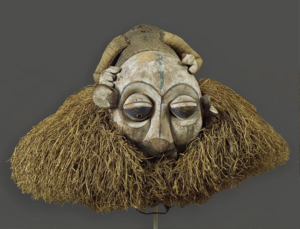
Headdress, 19th–20th century (Yaka peoples, Democratic Republic of the Congo), wood, cane, raffia, pigment, 45.1 x 61 x 54.6 cm (The Metropolitan Museum of Art, New York)
This mask was created to be worn during the initiation ceremonies of Yaka boys. It is composed of a carved wooden face with raffia collar attached to a basketry framework covered with fiber cloth. A four-legged beast crouches at the summit. Its outstretched fiber arms with carved wooden hands extend toward the face, which has exaggerated features. Enormous protruding circular eyes, a long nose, fangs, and cocked ears convey a sense of extraordinary curiosity and energy.
Among the Yaka, the institution responsible for initiation of boys into manhood is called nkhanda. In the past, boys resided within an initiation camp, located outside the village, for a training period of one to three years. Today, these initiations last approximately a week and provide historical, social, and religious instruction. The boys also undergo a number of physical ordeals, including circumcision, culminating in their symbolic death as children and rebirth as men.
Throughout their seclusion and upon conclusion of their training, members of nkhanda present a variety of masked performances. The masks are believed to offer protection to the boys during the period of physical and spiritual vulnerability. They also serve to introduce important Yaka moral and social precepts as well as to entertain. Historically, these masks were destroyed at the end of the initiation period.
Although the specific meaning of the imagery is unclear, Yaka masks generally illustrate ideas about gender differences, translating song lyrics that focus on male and female social responsibilities into visual form. On this mask, for example, the bulging eyes are round like the moon, relating to lunar cycles and, indirectly, alluding to the role of women.
© 2006 The Metropolitan Museum of Art, New York (by permission)


